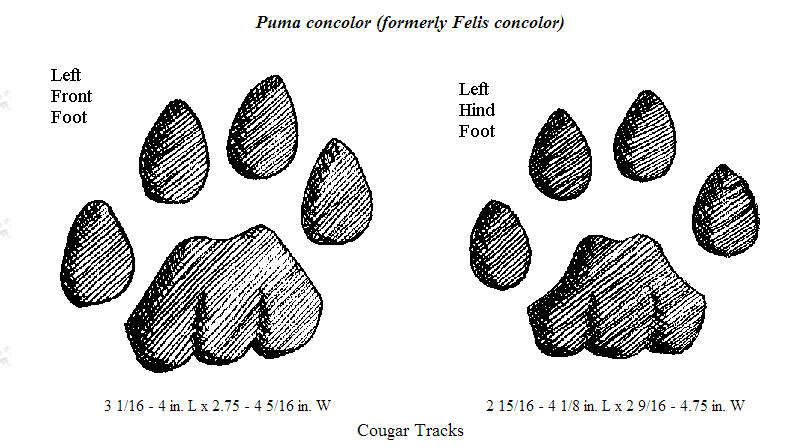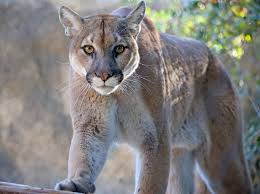

Front is usually slightly larger as it carries more weight due to the head and neck. Note no claw marks as they are retracted when walking.

Living with Mountain Lions
Mountain lions (puma, cougar) can be found throughout Arizona and are most common in rocky or mountainous terrain. Because mountain lions are shy and elusive, people do not often see them. However, the Arizona Game and Fish Department estimates the state’s mountain lion population is robust and increasing at 2,500 to 3,000. Mountain lions are solitary animals with the exception of females with kittens or breeding pairs. Signs of mountain lion presence include large tracks (3-5 inches wide) without claw marks; large segmented, cylindrical droppings; food caches where a kill has been partially eaten and then covered with leaves, brush or dirt; and scrapes in soft dirt or leaf litter.
| Description and Habits Tan or reddish brown to dusky or slate gray coat; young have numerous black spots that mostly disappear with age Long tail that is about 2/3 of body length, white underneath with a dark brown or black tip70-150 pounds (males usually larger than females)25-32 inches tall at the shoulder (similar to a German shepherd dog)5 ½ to more than 8 feet long Average litter of three kittens, which are yellowish-brown with black spots Kittens stay with mother for approximately 18 months Live up to 13 years in wild with average of less than 6 years Can jump 20 feet vertically and 40 feet horizontally in a single leap Rarely make vocal noises, unless during breeding season or when threatened Territory sizes range from 10 to 150 square miles; males range more widely than females Diet is primarily deer, but also includes javelina, bighorn sheep, elk, small mammals and occasional depredation on livestock and pets Possible Conflicts with Humans and Pets Urban sprawl often results in shrinking habitat and increases the number of conflicts between humans and wildlife, such as mountain lions. Conflicts can occur when a mountain lion becomes too accustomed to the presence of people, often near where we live or recreate, and begin preying on livestock or other domestic animals. Although uncommon, mountain lion attacks on humans occasionally occur. Mountain Lions are around us. What Attracts Them? Mountain lions most often pass through human-occupied space, but may stay longer if they have access to food, water, or shelter. Food sources found near people’s homes includes deer, javelina, rabbits, unsecured domestic animals, or livestock. Water for drinking can include a swimming pool, fountain, pond, or pet’s water bowl. Mountain lions might use “cave-like” areas beneath sheds, unused buildings, and storm drains, or elevated wooden patios, for shelter. Other factors that may contribute to mountain lions presence around humans include: Drought – Wildlife will come into urban fringe areas to search for food and water. Wildfires – Arizona wildfires damage vital habitat and force animals into new areas. Habituation to humans through close contact, exposure, and increased development near wildlife habitat. Humans feeding mountain lion prey (like javelina or deer), having livestock adjacent to wildlife habitat, and related activities create familiarity and habituation to humans. What Should I Do? Mountain lions are predators capable of seriously injuring or killing humans. The Arizona Game and Fish Department is committed to helping people learn how to behave responsibly and live safely in proximity to mountain lions, and to removing animals that are a potential threat to the public. The risk of attack by a mountain lion is small, but real; children are most at risk. Mountain lions may return repeatedly if food, water, or shelter is available. However, mountain lions use natural areas, such as washes, to move through populated areas to more remote areas, and such movements are necessary to prevent problems with inbreeding and local extinction associated with habitat fragmentation. If food, water, and shelter are not available, mountain lions generally move on to other areas more quickly. If you live or recreate in lion country, remain aware of your surroundings and take steps to minimize risks to yourself, your family, and pets. If you encounter a mountain lion: Do not approach the animal. Most mountain lions will try to avoid a confrontation. Give them a way to escape. Stay calm and speak loudly and firmly. Do not run from a mountain lion. Running may stimulate a mountain lion’s instinct to chase. Stand and face the animal. Make eye contact. Appear larger by raising your arms or opening your jacket if you are wearing one. Throw stones, branches, or whatever you can reach without crouching or turning your back. Wave your arms slowly. The idea is to convince the lion that you are not easy prey and that you may be a danger to it. Maintain eye contact and slowly back away toward a building, vehicle, or busy area. Protect small children so they won’t panic and run. Fight back if attacked. Many potential victims have fought back successfully with rocks, sticks, caps, jackets, garden tools, their bare hands, and even mountain bikes. Since a mountain lion usually tries to bite the head or neck, try to remain standing and face the animal. Report all mountain lion attacks to 911. All mountain lion encounters and attacks, sightings in urban areas, property damage due to mountain lions or possession of a live mountain lion should also be reported to your local Arizona Game and Fish Department office (8 a.m. to 5 p.m., Monday – Friday excluding holidays). After hours and weekends, a radio dispatcher is available at (623) 236-7201.If you live in mountain lion country, you should: Hike or walk in groups. Make noise when you’re outside. Closely supervise children whenever they play outdoors, especially in rugged country between dusk and dawn. Talk with children about mountain lions and teach them what to do if they encounter one. Keep dogs, cats, poultry, sheep, goats, rabbits, rodents and other domestic animals indoors or in a secure enclosure with a sturdy roof. Always walk pets on a leash. Roaming pets are easy prey for hungry mountain lions and coyotes. Do not feed pets outside and keep their food inside; the food can attract javelina and other mountain lion prey. Avoid feeding wildlife. By feeding deer, javelina, or other wildlife in your yard, you may inadvertently attract mountain lions, which prey upon them. Trim landscaping around your home. Remove dense and low-lying vegetation that can provide good hiding places for mountain lions and coyotes, especially around children’s play areas. Install outdoor lighting. Keep the house perimeter well lit at night, especially along walkways, to keep any approaching lions visible. Remember that mountain lion removal is usually a last resort. Relocation is not a viable option because it often ends in the severe injury or death of one or both lions in that territory. It is important to keep wildlife wild and remove whatever is attracting mountain lions. If people are regularly seeing a lion in a particular area, it may mean the lion represents a public safety risk. In some cases, the department may remove a lion that presents an imminent threat to human safety. A person may only harm a lion in self-defense or to defend another person (but see “Laws and Policies” section, below).To prevent further problems: Avoid using rodent poisons, which may poison mountain lions, as well as other animals. Close or patch-up any potential mountain lion shelter. Try using bright lights, flashing white lights, blaring music, barking dogs, and changes in the placement of scarecrow objects to temporarily repel mountain lions. Sprinklers and commercial motion-activated inflatable scarecrows startle animals when activated. Always work with your neighbors for a consistent solution. Possible Health Concerns Mountain lions are at risk of getting a variety of diseases, including those common to house cats, but little is known about their rates of illness. They are also subject to death by secondary poisoning from common rodent poisons that contain blood anticoagulants. Rabies – Symptoms of rabies can include foaming at the mouth, staggering, circling, and/or fearful, paralyzed, and lethargic behavior. If you see any wild animal with symptoms of rabies, call 911 or your local Game and Fish office immediately. Anyone bitten by a mountain lion must immediately seek medical attention for rabies shots unless the biting animal can be captured and tested for rabies. Notify the Arizona Game and Fish Department and your local health department immediately if any physical contact with a mountain lion occurs. Laws and Policies Mountain lions are classified as big game. A valid hunting license is required except in the case of depredation (killing of livestock) (ARS-17-302 and 17-239). The possession of a live mountain lion is illegal without Department approval and permit. State law prohibits discharging a firearm within a quarter-mile of an occupied farmhouse or other residence, cabin, lodge, or building while taking wildlife without permission of owner or resident. Check your local city ordinances, but most cities ban shooting firearms within city limits. Some cities ban the use of slingshots, BB guns, air guns, or bows. |
